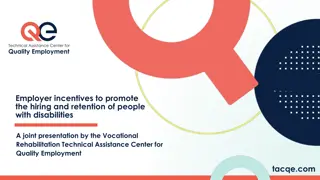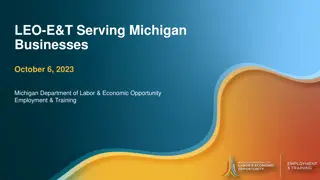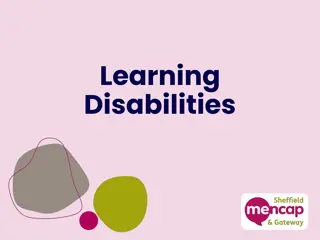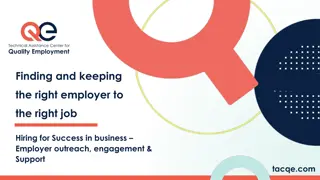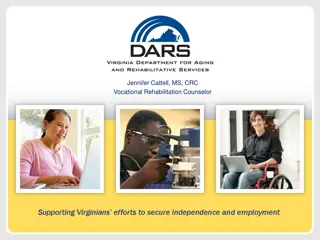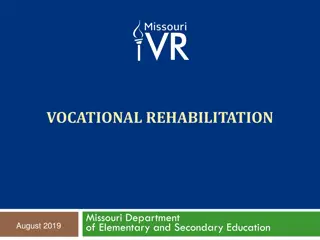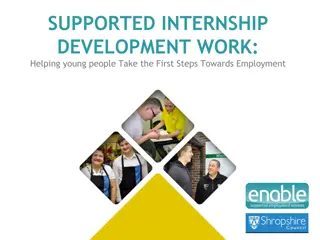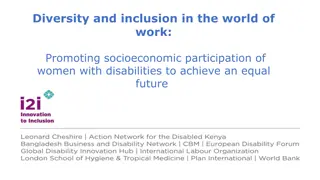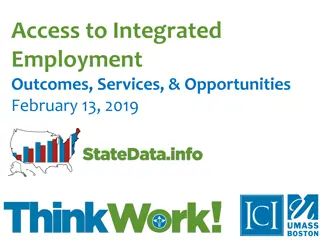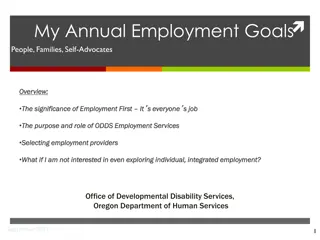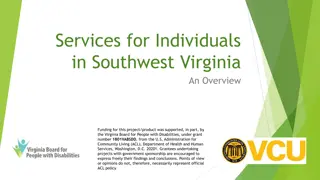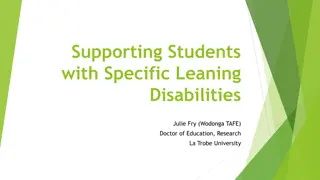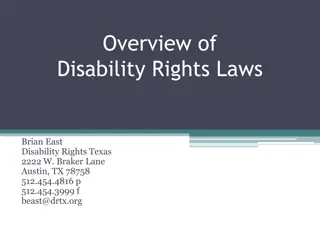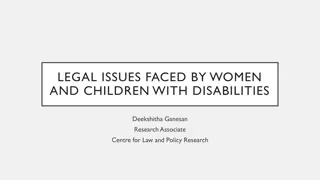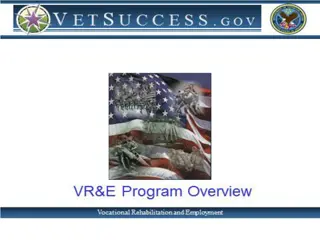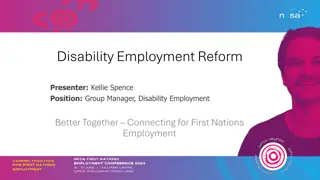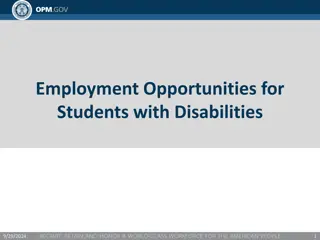Federal Employment of Individuals with Disabilities Overview
This detailed content highlights the efforts of recruiting, retaining, and honoring federal employees with disabilities, focusing on Executive Order 13548 aiming to enhance employment opportunities for individuals with disabilities. It also provides historical data on disability new hires and the permanent federal workforce. The resources and strategies outlined aim to support the inclusion and advancement of individuals with disabilities in the federal government.
Download Presentation

Please find below an Image/Link to download the presentation.
The content on the website is provided AS IS for your information and personal use only. It may not be sold, licensed, or shared on other websites without obtaining consent from the author.If you encounter any issues during the download, it is possible that the publisher has removed the file from their server.
You are allowed to download the files provided on this website for personal or commercial use, subject to the condition that they are used lawfully. All files are the property of their respective owners.
The content on the website is provided AS IS for your information and personal use only. It may not be sold, licensed, or shared on other websites without obtaining consent from the author.
E N D
Presentation Transcript
Recruiting, Retaining and Honoring Federal Employees with Disabilities Michael Murray Principal Advisor U.S. Office of Personnel Management (OPM) 1
Executive Order 13548 Increasing Federal Employment of Individuals with Disabilities Hire an additional 100,000 individuals with disabilities over five years Each agency submitted a Disability Employment Plan with the following: o A designated senior-level agency official to be accountable for enhancing employment opportunities o Performance targets and numerical goals for employees with disabilities o Provisions for training and education on disability employment o Provisions for reasonable accommodations and accessibility o Provisions for increased retention efforts and providing access to advancement opportunities for employees with disabilities OPM s Website for the Executive Order, supporting model strategies and other related disability employment resources: www.opm.gov/disability/ 2
Disability New Hires (1980-2012) ALL DISABILITY INCLUDING 30% OR MORE VETERANS TARGETED DISABILITY FISCAL YEAR ALL NEW HIRES % ALL DISABILITY % % 1980 163,827 994 0.61% 7,452 4.55% 8,079 4.93% 1981 139,447 825 0.59% 6,388 4.58% 7,277 5.22% 1982 121,466 761 0.63% 5,106 4.20% 5,969 4.91% 1983 115,447 763 0.66% 4,825 4.18% 5,612 4.86% 1984 142,019 982 0.69% 5,998 4.22% 6,959 4.90% 1985 151,866 1,026 0.68% 6,285 4.14% 7,231 4.76% 1986 128,372 902 0.70% 5,608 4.37% 6,428 5.01% 1987 136,491 938 0.69% 5,653 4.14% 6,500 4.76% 1988 127,130 928 0.73% 5,486 4.32% 6,246 4.91% In the past 32 years, people with disabilities have not been hired at such a high percentage in the Federal Government. 1989 148,583 965 0.65% 6,969 4.69% 7,854 5.29% 1990 117,222 844 0.72% 5,684 4.85% 6,304 5.38% 1991 124,099 1,155 0.93% 6,793 5.47% 7,597 6.12% 1992 102,411 1,134 1.11% 6,409 6.26% 7,330 7.16% 1993 70,358 757 1.08% 5,122 7.28% 5,731 8.15% 1994 57,457 519 0.90% 3,662 6.37% 4,263 7.42% 1995 121,235 1,596 1.32% 7,945 6.55% 8,620 7.11% 1996 53,303 316 0.59% 3,056 5.73% 3,736 7.01% 1997 59,470 423 0.71% 3,555 5.98% 4,275 7.19% 1998 65,381 479 0.73% 3,927 6.01% 4,754 7.27% 1999 68,129 585 0.86% 4,065 5.97% 5,112 7.50% 2000 80,822 631 0.78% 4,712 5.83% 5,957 7.37% 2001 94,698 696 0.73% 5,871 6.20% 7,465 7.88% 2002 132,968 721 0.54% 7,653 5.76% 9,412 7.08% 2003 204,399 1,043 0.51% 9,859 4.82% 13,080 6.40% 2004 88,679 530 0.60% 5,003 5.64% 7,343 8.28% 2005 100,408 544 0.54% 5,549 5.53% 8,774 8.74% 2006 102,949 569 0.55% 5,727 5.56% 9,437 9.17% 3 2007 112,669 732 0.65% 6,552 5.82% 10,819 9.60% 2008 152,257 1,053 0.69% 9,027 5.93% 15,407 10.12% 2009 156,306 1,071 0.69% 9,148 5.85% 16,706 10.69% 2010 151,999 1,178 0.78% 9,712 6.39% 18,926 12.45% 2011 127,487 1,122 0.88% 10,148 7.96% 18,675 14.65% 2012 102,093 1,101 1.08% 9,750 9.55% 16,653 16.31%
ALL DISABILITY INCLUDING 30% OR MORE VETERANS Permanent Federal Workforce TARGETED DISABILITY FISCAL YEAR ALL ON BOARD % ALL DISABILITY % % 1980 1,779,834 14,624 0.82% 121,013 6.80% 125,067 7.03% 1981 1,772,572 15,260 0.86% 118,254 6.67% 124,364 7.02% 1982 1,779,131 15,723 0.88% 116,149 6.53% 123,850 6.96% 1983 1,764,968 16,557 0.94% 114,828 6.51% 124,169 7.04% 1984 1,780,789 17,708 0.99% 116,389 6.54% 126,742 7.12% 1985 1,809,339 18,883 1.04% 117,336 6.49% 129,001 7.13% 1986 1,789,529 19,347 1.08% 115,587 6.46% 127,900 7.15% 1987 1,822,004 20,151 1.11% 116,392 6.39% 129,321 7.10% 1988 1,821,824 20,570 1.13% 117,614 6.46% 130,745 7.18% More people with disabilities work for the Federal Government now than in the past 32 years. 1989 1,845,876 21,288 1.15% 121,628 6.59% 134,930 7.31% 1990 1,848,435 21,693 1.17% 124,932 6.76% 138,099 7.47% 1991 1,877,323 22,493 1.20% 129,743 6.91% 143,023 7.62% 1992 1,879,894 23,036 1.23% 137,699 7.32% 150,809 8.02% 1993 1,823,193 22,713 1.25% 135,146 7.41% 148,043 8.12% 1994 1,755,221 21,989 1.25% 129,227 7.36% 142,191 8.10% 1995 1,693,177 21,245 1.25% 124,031 7.33% 137,050 8.09% 1996 1,640,258 20,212 1.23% 118,268 7.21% 131,683 8.03% 1997 1,585,408 19,190 1.21% 112,983 7.13% 126,831 8.00% 1998 1,556,531 18,507 1.19% 109,479 7.03% 123,957 7.96% 1999 1,536,156 18,051 1.18% 107,392 6.99% 122,571 7.98% 2000 1,524,883 17,730 1.16% 105,898 6.94% 121,756 7.98% 2001 1,536,627 17,564 1.14% 106,102 6.90% 123,088 8.01% 2002 1,579,254 17,417 1.10% 108,828 6.89% 127,417 8.07% 2003 1,582,636 17,187 1.09% 110,127 6.96% 129,782 8.20% 2004 1,602,773 16,917 1.06% 110,222 6.88% 134,025 8.36% 2005 1,611,400 16,458 1.02% 110,213 6.84% 137,578 8.54% 2006 1,608,157 16,048 1.00% 109,777 6.83% 140,622 8.74% 4 2007 1,618,159 15,910 0.98% 111,251 6.88% 145,486 8.99% 2008 1,673,249 16,030 0.96% 114,654 6.85% 154,555 9.24% 2009 1,757,105 16,560 0.94% 121,750 6.93% 169,530 9.65% 2010 1,831,719 17,445 0.95% 129,546 7.07% 187,068 10.21% 2011 1,856,580 17,845 0.96% 137,551 7.41% 203,694 10.97% 2012 1,850,311 18,319 0.99% 148,009 8.00% 219,975 11.89%
Schedule A Hiring In FY 2011, .98 percent of overall hiring were Schedule A appointees, doubling its use from FY 2010. In FY 2012 the federal Government increased Schedule A hiring to 1.51 percent of overall hiring. 5
GS 14s and 15s with Disabilities FY 2012, GS 14 s and 15 s with disabilities increased from 7.69 in FY 2011 to 8.61 percent. In FY 2012, GS 14 and 15 new hires with disabilities increased from 12.24 percent in FY 2011 to 14.65 percent. 6
Change is Now! I call for public and private sector employers to set goals for boosting disability employment, greater opportunities for entrepreneurs with disabilities, improved services to young people with disabilities that can lead to better employment outcomes after graduation, and bipartisan reforms to the largest disability entitlement programs so that they consistently support the efforts of people with disabilities to achieve success in the labor market and become part of the middle class. Senator Tom Harkin Unfinished Business: Making Employment of People with Disabilities a National Priority http://www.harkin.senate .gov/documents/pdf/500 469b49b364.pdf 7
Private Sector Walgreens, the country s largest drug store chain with over 7,000 stores nationwide, developed a plan to recruit a diverse workforce made up of at least 20 percent workers with disabilities in two of its distribution centers. In its Windsor, Connecticut site, employing over 400 employees, over 50 percent of those employees have a disability, including individuals with seizure disorders, autism, hearing impairments, visual impairments, cerebral palsy, intellectual disabilities and mental health disabilities. Broadening our workforce by employing people with disabilities is not only the right thing to do, but it also makes good business sense and has benefits that reverberate across our company and culture, Randy Lewis, Walgreen s Senior Vice President for Distribution 8
Federal Contractors On August 27, 2013, the U.S. Department of Labor s Office of Federal Contract Compliance Programs announced a Final Rule that makes changes to the regulations implementing Section 503 of the Rehabilitation Act of 1973, as amended (Section 503) at 41 CFR Part 60-741. Section 503 prohibits federal contractors and subcontractors from discriminating in employment against individuals with disabilities (IWDs), and requires these employers to take affirmative action to recruit, hire, promote, and retain these individuals. http://www.dol.gov/ofccp/regs/compliance/ section503.htm The new regulations under Section 503 of the Rehabilitation Act will have as great an impact on the lives of Americans with disabilities as the ADA. Tony Coelho, Former House Majority Whip and primary sponsor of the Americans with Disabilities Act 9
States as Model Employers of People with Disabilities 2012 2013 National Governors Association (NGA) Chair s Initiative A Better Bottom Line: Employing People with Disabilities http://www.nga.org/files/live /sites/NGA/files/pdf/2013/N GA_2013BetterBottomLine Web.pdf Employing people with disabilities is not about charity, but it's about what's in the business' best interest. Delaware Governor Jack Markell, Past Chari of the National Governors Association 10
Higher Education The U.S. Department of Labor's Office of Disability Employment Policy and The Higher Education Recruitment Consortium, signed an alliance agreement to promote the employment of people with disabilities throughout the higher education community. The two organizations are combining their expertise to increase recruitment, hiring, retention and advancement at colleges, universities, hospitals, research labs, government agencies and related organizations. http://chronicle.com/article/AgencyConsortium-Seek- to/138897/ http://www.dol.gov/opa/media/press/odep/odep20130795 .htm 11
Disability = Diversity Diversity + Inclusion = Innovation 12
Promising and Emerging Practices for Enhancing the Employment of Individuals with Disabilities Included in Plans Submitted by Federal Agencies Under Executive Order 13548 http://www.dol.gov/odep/pdf/FAEStrategies. pdf http://www.dol.gov/odep/pdf/2012EO13548. pdf 13
Policies and Practices in Private Industry The Employment Environment: Employer Perspectives, Policies and Practices Regarding the Employment of Persons with Disabilities by Cornell University Employment and Disability Institute http://digitalcommons.ilr.cornell.edu/cgi/viewco ntent.cgi?article=1328&context=edicollect 14
Improving the Participation Rate of People with Targeted Disabilities in the Federal Work Force by the Equal Employment Opportunity Commission http://www.eeoc.gov/federal/reports/pwtd.ht ml 15
States as Model Employers of People with Disabilities By Kathy Krepcio and Savannah Barnett John J. Heldrich Center for Workforce Development Rutgers, the State University of New Jersey http://askearn.org/docs/StateModel.pdf 16
1. Goals, Accountability & Data Support self-identification of disability Set hiring goals Accountability Evaluate data 17
2012 Federal Employee Viewpoint Survey In the 2012 FEVS, Federal employees with disabilities were given an opportunity to confidentially self-identify as a person with a disability and disclose their experience. Based on responses to FEVS workforce demographic questions, approximately 13.10 percent of Federal employees self-identified as having a disability. This, compared to FY 2012 data showing 11.89 percent of the Federal workforce self-identify as a person with a disability, results in an estimated data differential of 1.21 percent. 18
Will employees with disabilities disclose or self-identify? Percent of federal employees self-identifying in 2012 14.0 13.1% 11.9% 12.0 10.0 8.0 6.0 4.0 2.0 0.0 Federal Employee Viewpoint Survey Federal workforce self-identifing as a person with a disability 19
Goals & Accountability: E.O. 13548 is not an isolated effort but works in harmony with Equal Employment Opportunity Commission goals; E.O. 13518 on Employment of Veterans in the Federal Government issued on November 9, 2009; The Presidential Memorandum on Improving the Federal Recruitment and Hiring Process issued on May 11, 2010; Presidential Memorandum on The Presidential POWER Initiative: Protecting Our Workers and Ensuring Reemployment issued on July 19, 2010; E.O. 13583 on Establishing a Coordinated Government-wide Initiative to Promote Diversity and Inclusion in the Federal Workforce issued on August 18, 2011, to make sure people with disabilities have a fair shot in the Federal service. 20
Evaluate Data Separation Trends for 2009, 2010, 2011, 2012 (Percentages Calculated by Disability Status) After Notice Other Sub Total Other Sub Total Termination RFI/Funds Sub Total Other Sub Total Conduct No Disability Neutral 0.3% Neutral 26% Neutral 26% Neutral 2% Neutral 2% Increase 0.4 Increase 0.4 Neutral 19% Neutral 19% Neutral 1.5% Targeted All Disability Neutral 0.3% Neutral 20% Neutral 20.3% Neutral 4.5% Neutral 4.5% Neutral 0.2% Neutral 0.2% Increase 15% Increase 15% Decrease 1.9% Neutral 0.4% Neutral 21% Neutral 20% Neutral 4.5 Neutral 4.5 Neutral 0.3 Neutral 0.3 Increase 11% Increase 11% Decrease 2.5% Resignation Death Other New Placement Conduct and Performance Decrease 0.4% Increase 0.3% Decrease 4.3% Decrease 0.7% Decrease 7.9% Neutral 0.8% Neutral 0.8% Increase 50% Increase 50% Neutral 0.3% Increase 0.3% Decrease 3% Decrease 0.4% Decrease 6.5% Increase 2% Increase 2% Increase 44% Increase 44% Decrease 0.4% Neutral 0.1% Decrease 5.1% Decrease 1% Decrease 10% Increase 0.8 Increase 0.8 Neutral 49% Neutral 49% Moved Other Performance Sub Total Other Sub Total Other Sub Total Removal Other Retirement
2. Outreach & Recruitment Designate a task force or advisory body Ensure websites and other materials are welcoming, accessible, and easy to navigate Formalize partnerships with state agencies that work with people with disabilities Create opportunities for work experiences Use the Schedule A Hiring Authority for People with Disabilities (OPM Shared List, Workforce Recruitment Program) 22
The Schedule A Hiring Authority for People with Disabilities 23
Excepted Service Appointing Authorities The Executive branch has three civilian service systems; the competitive service, the excepted service and the Senior Executive Service. Excepted by Statute, Executive Order, or OPM action OPM s Government-wide excepted authorities listed under Schedules A, B, C, and D Cannot use traditional examining methods and not subject to OPM qualifications 5 CFR 213.3102 (u) appointing authority for people with intellectual disabilities, severe physical disabilities, and psychiatric disabilities 24 Excepted by Executive Orders 12125 and 13124
Schedule A Appointment of Persons with Disabilities Applies to appointment of persons with severe physical, intellectual, or psychological disabilities Improves the Federal Government s ability to hire persons with these disabilities Designed to remove barriers and increase employment opportunities for these individuals 25
Schedule A Appointment of Persons with Disabilities No public notice requirement Employment options: oTemporary appointments oTime limited appointments oPermanent appointments Time-in grade restrictions do not apply to promotions in the excepted service. Agencies can determine their own qualifications for positions under Schedule A, providing for an extra measure of flexibility. 26
Schedule A and the Senior Executive Service The Executive branch has three civilian service systems; the competitive service, the excepted service and the Senior Executive Service. Employees can be appointed to any of the three services using appropriate authorities for each particular service. 27
Schedule A Proof of Disability The following is a list of examples (not all- inclusive) of acceptable documentation of an intellectual disability, a severe physical disability or a psychiatric disability: oStatements or letters on a licensed physician s/medical professional s letterhead stationery. oStatements, records or letters from a Federal Government agency that issues or provides disability benefits. oStatements, records or letters from a licensed State Vocational Rehabilitation Agency counselor. oCertification from a private licensed Vocational Rehabilitation or other licensed Counselor that issues or provides disability benefits. 28
Schedule A Proof of Disability Certifying entities: A licensed medical professional (e.g., a physician or other medical professional certified by a State, the District of Columbia, or a U.S. territory to practice medicine) A licensed vocational rehabilitation specialist (i.e., State or private) Any Federal agency, State agency, or agency of the District of Columbia or a U.S. territory that issues or provides disability benefits 29
Applying Using Schedule A Individuals interested in applying under Schedule A should begin by taking the following steps: Identify an open position you want to apply for or an agency you would like to work for. oCheck USAJOBS at www.usajobs.gov oCheck agency websites for additional information and job openings Prepare your application. This should include: oResume and any other documentation requested in the job announcement, such as a writing sample, college transcript, etc. oProof of disability. 30
Applying Using Schedule A Once you have the appropriate documentation, you can: 1. Apply through the competitive hiring process for a specific job and note in the application that you are eligible to be considered under Schedule A. 2. Contact a Disability Program Manager (DPM), Selective Placement Program Coordinator (SPPC) or agency equivalent at the agency where you plan to apply and give them your resume and documentation. You can ask to be considered for any current or future hires at the agency that you would be qualified for. Contact information will be on the hiring announcement or you can search a directory of SPPCs on the Office of Personnel Management website. http://apps.opm.gov/sppc_directory 31
Schedule A - Conversion An agency may noncompetitively convert to a career or career conditional appointment in the competitive service an employee who: oCompletes 2 or more years of satisfactory service, without a break of more than 30 days, under nontemporary Schedule A appointments; oIs recommended for conversion by their supervisors; oMeets all requirements and conditions governing career and career-conditional appointment except those requirements concerning competitive selection from a register and medical qualifications; and oIs converted without a break in service of one workday (Refer to 5 CFR 315.709). 32
OPM Shared List The Chief Human Capital Officers Council developed a list of people with disabilities who are seeking jobs in a number of professions. The OPM Chief Human Capital Officers Shared List of People with Disabilities is a database of candidates with disabilities who are eligible to apply for employment through the Schedule A hiring authority. Job seekers with disabilities can learn more about this opportunity at http://www.benderconsult.com/employers/government- agencies. Interested job seekers with disabilities may submit r sum s to Bender Consulting Services via e-mail at resume@benderconsult.com or online at http://www.benderconsult.com/careers/submit-resume. 33
OPM Shared List Process OPM has contracted with Bender Consulting Services to populate a shared list of applicants, who are Schedule A eligible and have an interest in working for federal agencies. Bender Consulting recruits, screens and directs a approximately 50 qualified candidates with disabilities, on a monthly basis. The OPM Shared List of People with Disabilities database is available on the Max Federal Community Agency representatives may access the database by registering for a user id on www.max.gov o Search for Shared List of People with Disabilities
Bender Consulting Background National leader in recruitment and hiring of people with disabilities for professional positions in the public and private sectors Headquartered in Pittsburgh, PA with a national network CEO / President, Joyce Bender immediate past- chair, national Epilepsy Foundation and the American Association of People with Disabilities Federal government experience NSA; FAA; NAVSUP; NAVAIR; US Fish and Wildlife Service; Veterans Affairs Private sector experience Highmark, Bayer Corporation, CSC, WellPoint and others
OPM Shared List Features OPM Shared List of People with Disabilities is located on the OMB Max Federal Community Screened, qualified Schedule A Eligible applicants Direct access to applicant information, including resumes Allows searching for applicants based on geography and job occupation Can be accessed through www.max.gov; search for shared list OPM Shared GIFT
OPM Shared List Activity (As of Jan 2014) OPM Shared List of People with Disabilities database available on max.gov 1,137 active candidates Agencies have used the list over 12,914 times over the past four years. In general, the Shared List contractor screens 3 candidates for every 1 candidate that is entered into the Shared List. Every candidate vetted for the Shared List is afforded valuable support and training on interview preparation, the hiring process (competitive and non-competitive ) and resume development, better preparing them to seize employment opportunities.
OPM Shared List Activity (As of Jan 2014) Candidates have been hired from the OPM Shared List at levels ranging from GS-3 to GS-15. Many agencies have hired candidates from the Shared List, including: Centers for Disease Control and Prevention; Defense Contract Audit Agency; Defense Contract Management Agency; Defense Logistics Agency; Department of Agriculture; Department of Commerce; Department of Defense; Department of Education; Department of Energy; Department of Health and Human Services; Department of Homeland Security; Department of Housing and Urban Development; Department of the Interior; Department of Justice; Department of Labor; Department of the Navy; Department of Transportation; Department of the Treasury; Federal Aviation Administration; Federal Mine Safety and Health Review Commission; Food and Drug Administration; General Services Administration; Internal Revenue Service; National Oceanic and Atmospheric Administration; Office of Personnel Management; Social Security Administration; Veterans Affairs; National Security Agency Note: The above is not an exhaustive list.
OPM Shared List Job Occupations Accountant Budget Analyst Contact Representative Contract Specialist Human Resources Specialist Financial Management Specialist Information Technology Specialist Secretary Miscellaneous Clerk and Assistant Sciences US FWS BPA** Medical Fields VA BPA** Human Resources Assistant ** Blanket Purchase Agreements (BPA) for customized recruitment
Candidate Screening Position preference Education oQPA/GPA oDegree Experience Position Requirements Match Geographic preference Attitude Flexibility Responsiveness Desire to do the job
OPM Shared List Process People with disabilities may apply for inclusion in the Shared List by e-mailing a resume to resume@benderconsult.com, or applying on- line at www.benderconsult.com. Agency representatives schedule interviews directly with the candidates and provide any necessary accommodations for the interview process.
3. Reasonable Accommodations Educate employees about reasonable accommodations. Centralized Accommodation Funding Support reasonable accommodations policies and procedures Ensure information technology systems are fully accessible 44
4. Retention & Advancement Utilize return to work as the first option for workers who acquire disabilities Conduct exit interviews and stay interviews Support career development trainings and plans Hire and promote people with disabilities at all levels Create and support Employee Resource Groups Train managers on disability etiquette and best practices Develop emergency management plans that specifically address the needs of employees with disabilities. Utilize communities of practice on employment of people with disabilities. 45
Additional Resources A Better Bottom Line: Employing People with Disabilities http://www.nga.org/files/live/sites/NGA/files/pdf/2013/NGA_2013B etterBottomLineWeb.pdf OPM Disability Employment http://www.opm.gov/policy-data- oversight/disability-employment/getting-a-job/ Summary of Promising and Emerging Practices for Enhancing the Employment of Individuals with Disabilities Included in Plans Submitted by Federal Agencies under Executive Order 13548 http://www.dol.gov/odep/pdf/2012EO13548.pdf Department of Labor s Office of Disability Employment Policy http://www.dol.gov/odep/topics/FederalEmployment.htm 47
Additional Resources Equal Employment Opportunity Commission s ABC s of Schedule A http://www.eeoc.gov/eeoc/initiatives/lead/abcs_of_schedule_a.cfm Improving the Participation Rate of People with Targeted Disabilities in the Federal Work Force- http://www.eeoc.gov/federal/reports/pwtd.html The Employment Environment: Employer Perspectives, Policies and Practices Regarding the Employment of Persons with Disabilities by Cornell University Employment and Disability Institute- http://digitalcommons.ilr.cornell.edu/cgi/viewcontent.cgi?article=132 8&context=edicollect States as Model Employers of People with Disabilities By Kathy Krepcio and Savannah Barnett at the John J. Heldrich Center for Workforce Development, Rutgers, the State University of New Jersey- http://askearn.org/docs/StateModel.pdf 48
Contact Information Phone: 202.606.0020 Email: disabilityemployment@opm.gov Additional Resources: www.opm.gov/disability


